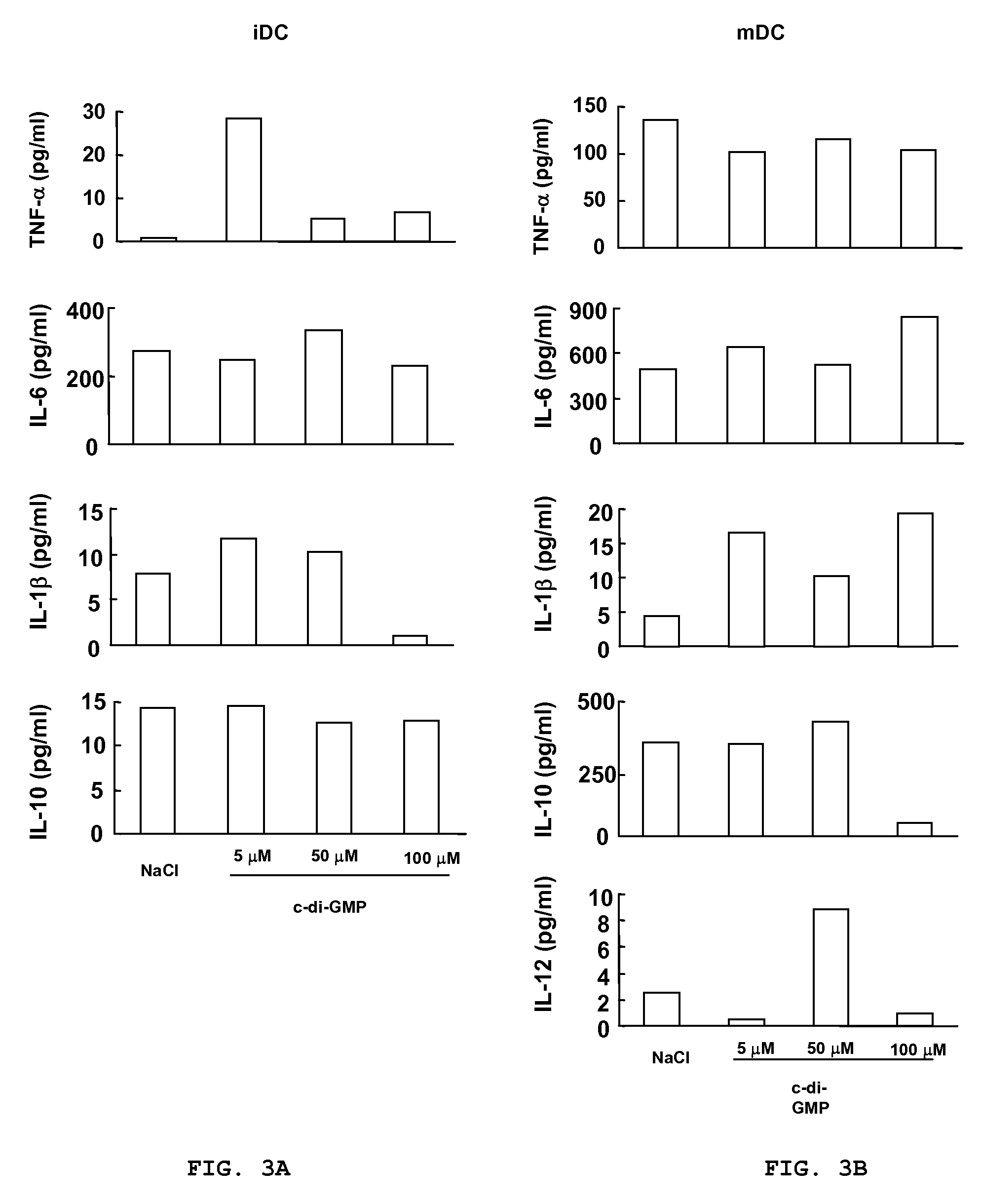Method for stimulating the immune, inflammatory or neuroprotective response
a technology of immune, inflammatory or neuroprotective response and stimulation method, which is applied in the direction of antibody medical ingredients, drug compositions, immunological disorders, etc., can solve the problems of multisystem dysfunction and death, ineffective stimulation of t cells, widespread systemic dissemination and death, etc., to inhibit, treat or ameliorate the effect, and inhibit the
- Summary
- Abstract
- Description
- Claims
- Application Information
AI Technical Summary
Benefits of technology
Problems solved by technology
Method used
Image
Examples
example 1
Preparation of Cell Culture and Treatments
[0124]Peripheral blood mononuclear cells (PBMC) were isolated by Ficoll-Hypaque gradient separation of buffy coats obtained from healthy volunteer blood donors by the Transfusion Center of Università Degli Studi “La Sapienza” Rome. DCs were generated from monocytes purified from PBMC by positive selection using magnetic cell separation columns and CD14 Microbeads. Highly enriched monocytes (>95% CD14+) were cultured at 6×105 / ml in RPMI 1640 medium supplemented with 15% heat-inactivated fetal calf serum (FCS), L-glutamine and penicillin-streptomycin and 250 ng / ml granulocyte macrophage-colony stimulating factor (GM-CSF) and 500 U / ml interleukin (IL)-4 at 37° C. for 5 days. Differentiation to DC was assessed both by morphologic observation and the detection of specific surface markers by flow cytometry. These cells were CD14−, CD1a+, HLA-DRintermediate, HLA-ABCintermediate CD80low, CD86low consistent with an immature DC phenotype. Untreated im...
example 2
Use of Cyclic Dinucleotides to Inhibit Bacterial Pneumonia Caused by Klebsiella pneumoniae
[0189]To determine the effect of c-di-GMP pretreatment on survival in mice challenged with K. pneumoniae (a Gram-negative bacterial pathogen), female specific pathogen-free 6 to 8 week-old Balb / c mice were treated with c-di-GMP (200 nmoles) or vehicle i.n. or s.q. at both 48- and 24 hrs prior to the i.t. administration of K. pneumoniae (5×103 CFU), then assessed for survival. The virulent K. pneumoniae strain 43816, serotype 2 (ATTC, Manassas, Va.) was used. For i.n. administration, c-di-GMP, the nucleotide control c-GMP, or vehicle (phosphate buffered saline (PBS)) was administered i.n. in a 10 ul volume. For i.t. administration of bacteria, the trachea was exposed, and 30 ul of inoculum was administered via a sterile 26-gauge needle. The skin incision was closed using surgical staples. Survival curves were compared using the log rank test.
[0190]In previously published studies, it was shown t...
example 3
Use of Cyclic Dinucleotides (e.g. c-di-GMP) to Inhibit Francisella tularensis Infection
[0205]Francisella tularensis is a Gram-negative bacterial pathogen and the cause of tularemia. An attenuated live vaccine strain, F. tularensis LVS, was developed almost 50 years ago, and remains the sole prophylactic against virulent strains of the pathogen. Two subspecies (type A and B strains) of the pathogen exist, the former being much more virulent than the latter for humans and other higher mammals. F. tularensis is an extremely virulent facultative intracellular bacterial pathogen of many mammalian species including mice and humans. In humans, intradermal or inhaled inocula of 10 cfu or less of the most virulent strains of the pathogen are sufficient to cause severe infection and possible death; in mice similar inocula are routinely lethal.
[0206]Using F. tularensis LVS as a model vaccine, it is possible to systemically immunize various mouse strains and protect them against subsequent mass...
PUM
| Property | Measurement | Unit |
|---|---|---|
| pH | aaaaa | aaaaa |
| weight | aaaaa | aaaaa |
| weight | aaaaa | aaaaa |
Abstract
Description
Claims
Application Information
 Login to View More
Login to View More - R&D
- Intellectual Property
- Life Sciences
- Materials
- Tech Scout
- Unparalleled Data Quality
- Higher Quality Content
- 60% Fewer Hallucinations
Browse by: Latest US Patents, China's latest patents, Technical Efficacy Thesaurus, Application Domain, Technology Topic, Popular Technical Reports.
© 2025 PatSnap. All rights reserved.Legal|Privacy policy|Modern Slavery Act Transparency Statement|Sitemap|About US| Contact US: help@patsnap.com



